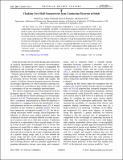Cloaking Core-Shell Nanoparticles from Conducting Electrons in Solids
Author(s)
Liao, Bolin; Zebarjadi, Mona; Esfarjani, Keivan; Chen, Gang
DownloadLiao-2012-Cloaking Core-Shell Nanoparticles from Conducting Electrons in Solids.pdf (542.4Kb)
PUBLISHER_POLICY
Publisher Policy
Article is made available in accordance with the publisher's policy and may be subject to US copyright law. Please refer to the publisher's site for terms of use.
Terms of use
Metadata
Show full item recordAbstract
In this Letter, we aim at making nanoparticles embedded in a host semiconductor with a size comparable to electronic wavelengths “invisible” to the electron transport. Inspired by the recent progress made in optics and working within the framework of the expansion of partial waves, we demonstrate that the opposite effects imposed by potential barriers and wells of a core-shell nanoparticle on the phase shifts associated with the scattered electron wave could make the scattering cross section of the first two partial waves vanish simultaneously. We show that this is sufficient to cloak the nanoparticle from being detected by electrons with specific energy in the sense that a total scattering cross section smaller than 0.01% of the physical cross section can be obtained and a 4 orders of magnitude difference in the total scattering cross section can be presented within an energy range of only 40 meV, indicating possible applications of the “electron cloaks” as novel electronic switches and sensors, and in efficient energy harvesting and conversion technologies.
Date issued
2012-09Department
Massachusetts Institute of Technology. Department of Mechanical EngineeringJournal
Physical Review Letters
Publisher
American Physical Society
Citation
Liao, Bolin et al. “Cloaking Core-Shell Nanoparticles from Conducting Electrons in Solids.” Physical Review Letters 109.12 (2012). © 2012 American Physical Society
Version: Final published version
ISSN
0031-9007
1079-7114